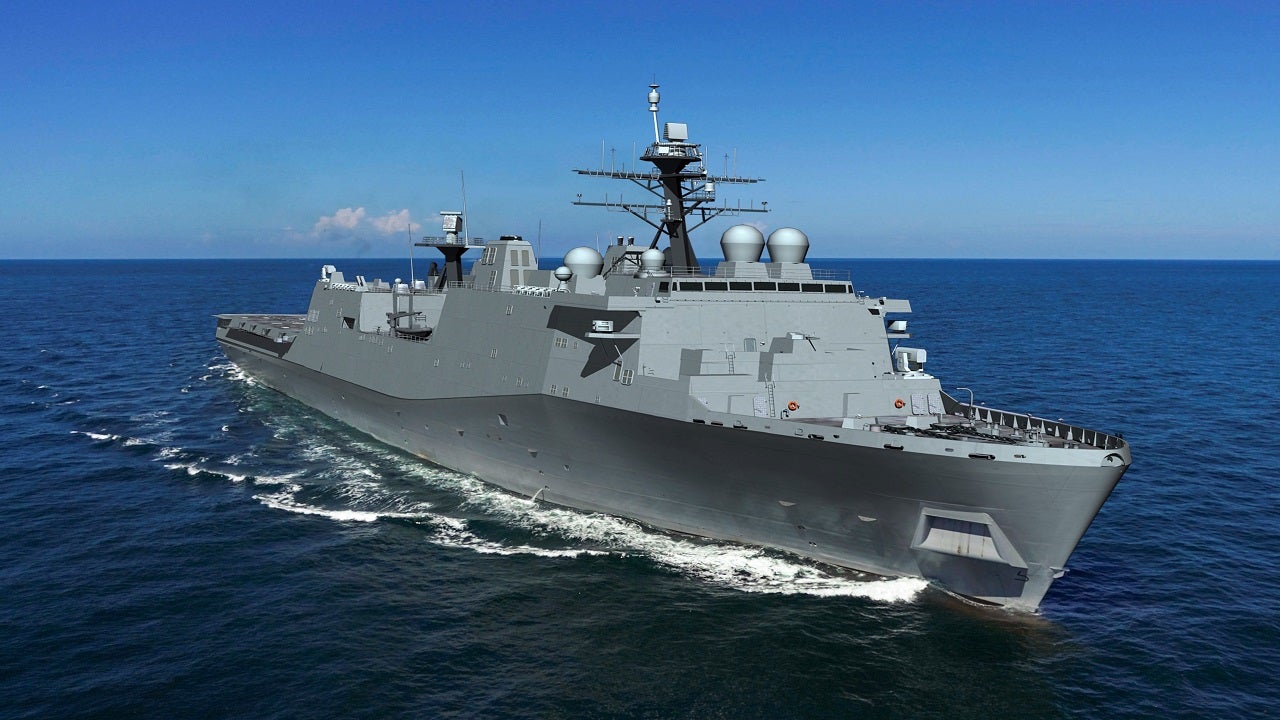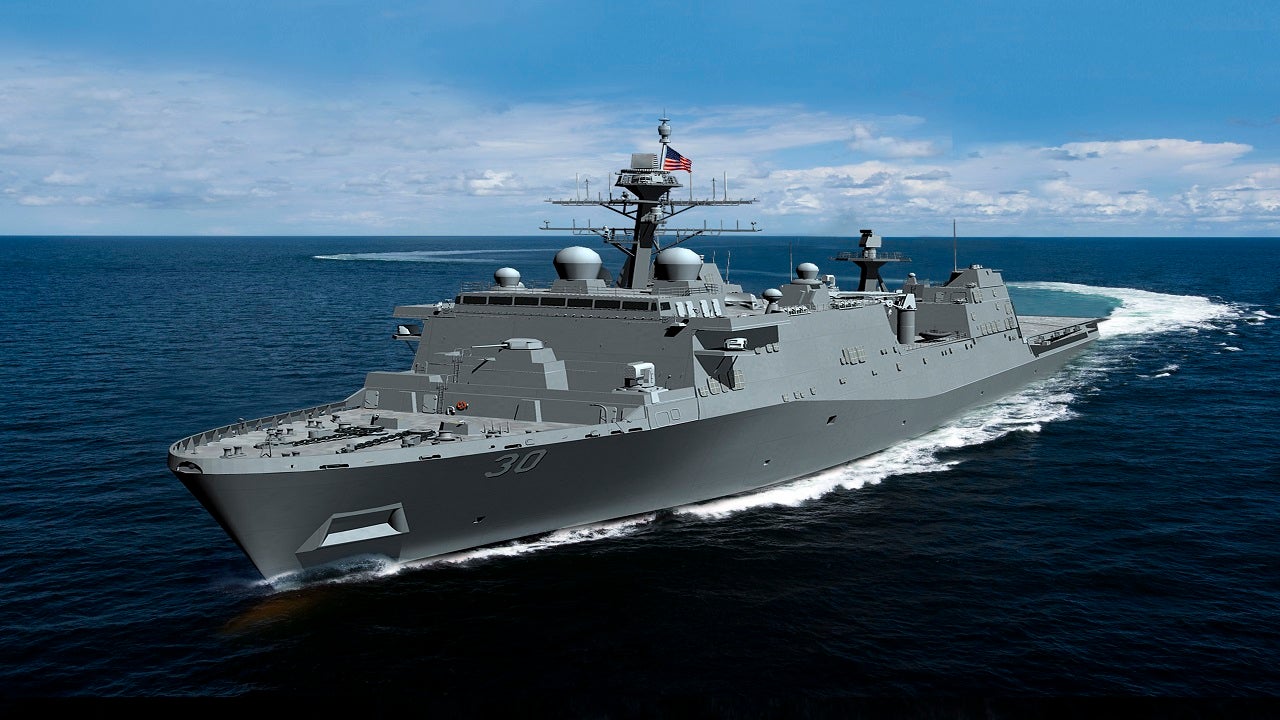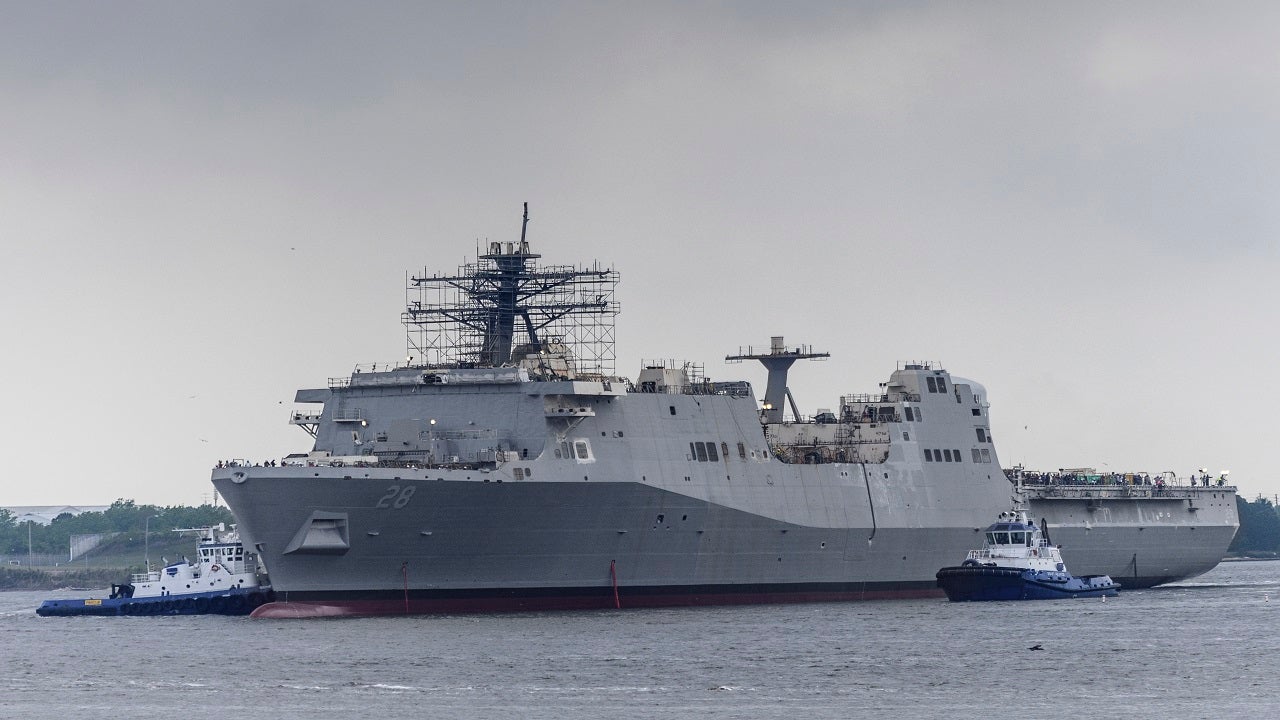The San Antonio class landing platform dock is the latest class of amphibious force ship for the US Navy.
The mission of the San Antonio class is to transport the US Marine Corps ‘mobility triad’, including advanced amphibious assault vehicles (AAAVs), landing craft air cushion (LCAC), and the MV-22 Osprey tilt-rotor aircraft, to required spots around the world.
The US Navy has commissioned 11 San Antonio class LPD flight I ships to date.
USS San Antonio (LPD 17) amphibious transport dock
The construction of the first ship, the San Antonio (LPD 17), began in June 2000, followed by its keel-laying ceremony in December 2000. It was launched in July 2003 and commissioned in January 2006. The San Antonio is home-ported at the Norfolk naval base, Virginia. The vessel achieved initial operating capability (IOC) in May 2008 and made its first deployment in August 2008 as part of the Iwo Jima expeditionary strike group.
USS New Orleans (LPD 18) and USS Mesa Verde (LPD 19)
The keel of the second ship, New Orleans (LPD 18), was laid in October 2002. It was launched in November 2004, delivered in December 2006, and commissioned in March 2007. The keel of the third, Mesa Verde (LPD 19), was laid in February 2003, launched in January 2005, and commissioned in December 2007.
USS Green Bay (LPD 20)
The keel for the fourth, USS Green Bay (LPD 20), was laid in August 2003, launched in August 2006, and delivered in August 2008. It was commissioned in January 2009. New Orleans and Green Bay are home-ported at San Diego.
USS New York (LPD 21)
The keel for USS New York (LPD 21) was laid in September 2004. It was launched in December 2007 and commissioned in November 2009. The construction of USS New York included 24t of steel salvaged from the wreckage of the World Trade Center as a memorial to those who lost their lives in New York on 11 September 2001.
USS San Diego (LPD 22)
The keel of USS San Diego (LPD 22) was laid in May 2007 and launched in May 2010. The ship was delivered to the US Navy in December 2011 and commissioned in May 2012.
USS Anchorage (LPD 23), USS Arlington (LPD 24), and USS Somerset (LPD 25)
Other contracted vessels are the Anchorage (LPD 23), Arlington (LPD 24), Somerset (LPD 25), and Murtha (LPD 26).
USS Anchorage was laid in September 2007, launched in February 2011, and delivered to the US Navy in September 2012. It was commissioned into the Navy in May 2013.
USS Arlington’s keel was laid in May 2008 and launched in November 2010. It was delivered to the US Navy in December 2012 and commissioned in April 2013, following the completion of builder’s trials in August 2012.
The keel of the USS Somerset was laid in December 2009. It was launched in April 2012 and christened in July 2012. The LPD was delivered to the US Navy in October 2013 and commissioned in March 2014. It is home-ported at Naval Base San Diego.
John P Murtha (LPD 26) was launched in October 2014. It was christened in March 2015, delivered to the US Navy in May 2016, and commissioned in October 2016.
LPD 27
Huntington Ingalls Industries was awarded a $1.5bn contract by the US Navy for construction of the 11th ship in the class, the Portland (LPD 27), in July 2012.
The first steel was cut in August 2012 and its keel was laid in August 2013. The vessel was launched in February 2016, delivered in September 2017, and commissioned in April 2018.
Fort Lauderdale (LPD 28) and Richard M McCool Jr (LPD 29)
Huntington Ingalls Industries received a $1.46bn contract for the design and construction of USS Fort Lauderdale (LPD 28) in December 2016. The keel for the vessel was laid in October 2017 and the vessel was launched in March 2020 with delivery scheduled for 2021.
The shipyard was awarded a $1.43bn detail design and construction contract for Richard M McCool Jr (LPD 29) in February 2018 and the keel was laid in April 2019.
LPD-17 Flight II ships
Huntington Ingalls Industries received a $165.5m contract to acquire long-lead-time material and perform advance construction activities of LPD 30 ship (USS Harrisburg) in August 2018. It will be the first Flight II LPD of the class.
LPD-17 Flight II, the latest version of the San Antonio class, is being built to meet the operational requirements of the US Navy and Marine Corps by replacing the LSD-41/49 class ships. The vessels will incorporate minor modifications to feature a ship-to-shore connector, CH-53K helicopter, and improved troop armament stowage.
A $1.47bn contract for the detail design and construction of LPD 30 was awarded to Huntington Ingalls Industries in March 2019. It was followed by a $1.5bn contract for the construction of the second vessel, LPD 31, which was awarded in April 2020.
The construction of the LPD 30 began in April 2020, signifying the cutting of first 100t of steel.
The LPD 28 and 29 ships incorporate few design changes as part of the transition from Flight I to Flight II class.
San Antonio class contractors
The US Navy awarded a contract to an industrial alliance led by Northrop Grumman Ship Systems (formerly Litton Avondale), with General Dynamics Bath Iron Works, Raytheon Electronic Systems, and Intergraph Corporation, to design and construct the first of 12 ships under the navy’s LPD 17 programme in December 1996.
It was planned that Avondale would build eight and Bath Iron Works four ships.
However, in June 2002, the US Navy signed a memorandum of understanding (MoU) with Northrop Grumman and Bath Iron Works, making Northrop Grumman responsible for the construction of all San Antonio class vessels. Bath is the builder of four Arleigh Burke destroyers, previously assigned to Northrop Grumman.
Ingalls Shipbuilding received a $34.8m contract for engineering and support services for LPD 17 and a $200m contract to provide long-lead-time material and main equipment for LPD 28 in December 2015.
AMSC secured a contract to deliver a ship protection system for LPD 28 in January 2019. In July 2020, it was awarded another contract for a high-temperature conductor (HTS)-based ship protection system for LPD 31.
San Antonio class design
The ship uses steel in its construction and has low radar cross-section.
Enhanced survivability features include improved fragmentation and nuclear blast protection, as well as a shock-hardened structure. Automation and integration of systems have enabled a significant reduction in the crew, projected to be 361.
The 684ft-long, 105ft-wide ship provides three vehicle decks of 25,402ft² and two cargo holds, with 25,548ft³ for bulk cargo and ammunition magazines in addition to the 1,234m³ for cargo fuel.
Accommodation is provided for two LCAC, 700 troops, and 14 new AAAVs. Each LCAC can carry 60t of cargo and vehicles, including the M1A2 Abrams tank at speeds of up to 40k.
The ship’s advanced enclosed mast / sensor (AEM/S) system consists of two large eight-sided structures, which accommodate the radar and communications antennae with a hybrid frequency-selective surface. As well as reducing the ship’s radar cross-section, the AEM / S system also protects the equipment from exposure to the elements.
Aircraft carrying capabilities of the San Antonio class
At the stern of the ship, the landing deck is able to accommodate two Sikorsky CH-53E Sea Stallion helicopters, six Bell AH-1W Super Cobra helicopters, four Boeing CH-46 Sea Knight helicopters or two Boeing Bell MV-22 Osprey tiltrotor aircraft.
The hangar deck provides aviation maintenance facilities and is sufficiently large to accommodate one Sea Stallion, two Sea Knights, three Super Cobra helicopters or one MV-22 Osprey tiltrotor aircraft.
The blast-resistant hangar doors, which were constructed by Indal Technologies, weigh 18,000kg and have three horizontal folding panels each.
USS San Antonio began flight operations testing with the V-22 Osprey tiltrotor and CH-46 Sea Knight helicopter in June 2006.
Weapon systems
Two mk31 mod 0 launchers can launch the fire-and-forget Raytheon rolling airframe missile (RAM). The RAM (RIM 116) surface-to-air missile has dual-mode radio frequency / infrared guidance and is designed to engage anti-ship missiles within a range of 8km.
Space and weight provision has been made for the future fitting of a vertical launcher for the evolved Seasparrow missile (ESSM) if required.
The ship is equipped with two mk46 mod 2 30mm guns for close-in surface self-defence. The mk46 is a dual-axis stabilised chain gun with a firing rate of up to 250 rounds a minute. The fire director includes a thermal imager, low-light TV camera, and laser rangefinder, with a closed-loop tracking system.
The gun can be operated locally at the gun turret or remotely in the combat information centre. Additional armament includes two mk26 mod 18 50-calibre machine guns.
SSDS (ship self-defence system)
San Antonio is one of the classes of vessels to receive the ship self-defence system (SSDS) mk2 developed by Raytheon for the US Navy. SSDS is an integration of all the ship’s self-defence systems and includes multifunction radar, advanced integrated electronic warfare system, and an infrared search-and-track (IRST) system.
LPD 22, the sixth of the class, was the first ship to receive the complete system.
The ship is equipped with a fibre-optic shipboard wide area network (SWAN) from Raytheon, which connects ship systems, sensors, and combat systems to the ship’s command consoles.
Harris was awarded a contract to provide high-frequency (HF) radio broadband communications systems for the San Antonio class in February 2004.
Countermeasure technology of San Antonio class vessels
The ship is equipped with the AN / SLQ-25A Nixie towed decoy system from Argon ST of Fairfax, Virginia, and the mk53 Nulka decoy launching system developed by the Australian Defence Science and Technology Organisation in Canberra and Lockheed Martin Sippican in Massachusetts.
Nulka is a hovering rocket system, which deflects incoming missiles away from the ship. The Raytheon AN / SLQ-32A (V) 2 electronic support measures (ESM) system is a detection and jamming system, providing surveillance, warning, and electronic countermeasures against missile attack.
LPD 22 and later vessels are fitted with the advanced integrated electronic warfare system (AIEWS).
Sensors and propulsion
The ship’s radars include an ITT AN / SPS-48E 3D air search radar, operating at C / D band, Lockheed Martin’s AN / APQ-9B surface surveillance and tracking radar, operating at I band, Raytheon’s AN / SPS-64(V)9 navigation radar, operating at I band, and two Northrop Grumman Norden Systems AN/SPS-73 surface search radars, operating at I-band.
The ship is powered by four Colt-Pielstick 2.5 STC diesel engines, developing 10,400hp each. The main reduction gears from Philadelphia Gear Corp turn two shafts with Bird Johnson controllable pitch propellers.
A new high-power, ‘low-drag’ propeller hub design provides improved propeller efficiency.
The ship’s electrical power is provided by five 2,500kW Caterpillar ship service diesel generators (SSDG) with self-cleaning strainers and filters and electric pumps. Seven 200t York air-conditioning units are fitted for cooling systems and habitation.
The ship auxiliary systems are all-electric, including heating, water heaters, and a 72,000gpd reverse osmosis water-generating plant.










